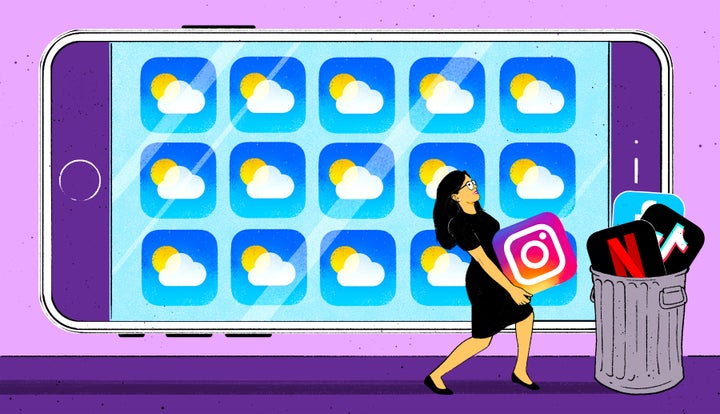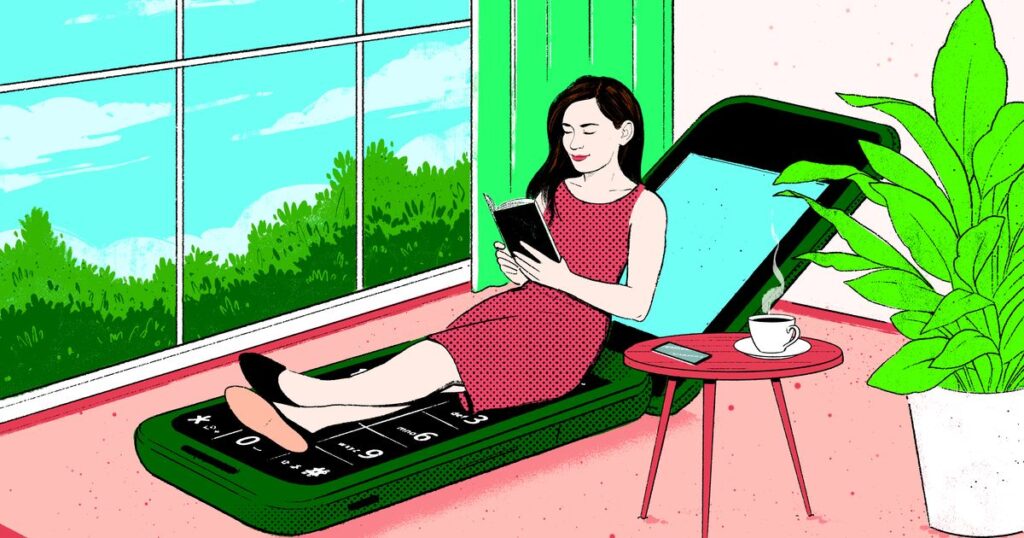It started as a joke. I’d hear the ding of an incoming email or the buzz of a new text on my iPhone and groan. “I’m going to smash this thing,” I’d deadpan to my husband, my children — anyone within earshot. When, inevitably, the 10th school notification of the day came through — “Today in PE, first graders practiced their coordination using hula hoops!” — I’d threaten to move to the rainforest, leaving my phone behind. “No, seriously,” I’d proclaim, shoving the vibrating rectangle deep between two sofa cushions. “I’m getting a flip phone.”
Then I did some math, and my joking became a bit more earnest. According to my iPhone, my usage was clocking in at around 3 1/2 hours every day. I was an English major, but I’m pretty sure 3 1/2 hours a day is 1,277 hours a year. If I lived 40 more years (until 80), I was on track to spend about six of those years scrolling. Or, to look at it another way, I would stare at my phone for roughly 22% of the waking hours I had left.
This might have felt like a worthwhile use of time if I’d been hearting Instagram posts or even laughing at ridiculous TikToks. But no, I wasn’t sure what I was doing on my phone for more than three hours every day. Ordering things, checking things, confirming things? Six years of my life were going to be spent completing infinite inane tasks forgotten by bedtime.
I am not alone. Forty-two percent of Americans in my age bracket (30-49 years old) say they are online “almost constantly.” Adults 35-44 spend about two hours a day on social media; the remainder of their online time is likely obligatory: emails, Slack for work, and Schoology or Classtag for their kids. Whenever I told friends I wanted to ditch my smartphone, I got the same response: “I would love to do that, but … how can you?!”
How, indeed. I asked my Instagram followers for tips and recommendations. One sent me instructions for moving a SIM card into a flip phone, a thing she had learned while caring for her elderly grandfather. Others sent articles about high schoolers forming “flip phone clubs.” A few were baffled by the idea, but the most common response I got was, “Report back if this works.”
That’s because we’d all imagined it, but none of us had any idea whether it was really possible. Sure you can quit your smartphone if you are a hermit, live off the grid, don’t have a job or aren’t a parent. Maybe it is more possible if you are very young or very old. But can a mother of four — who’s also a wife and writer with a wide network of clients, friends and elementary school contacts, and who pays babysitters, orders groceries and sends invoices — maintain something resembling modern life without a smartphone? Or has the operating system closed in around us, mandating not only our priorities but our very existence?
I made the announcement to my family one Saturday morning during breakfast: I would quit my iPhone, cold turkey, for 100 days. Day one was set as the last day of my kids’ school year.
My husband raised his eyebrows and asked, “But how will you take pictures?” He knew precisely where the absence would hit me hardest.
I mumbled something about finding my old DSLR camera, which my oldest daughter, age 10, pointed out was heavy, huge and looked “not very cool.”
It wasn’t until I began researching “dumb phones” that the gravity of my declaration began to sink in, and I ticked off the things I would need to give up for my “experiment in well-being”:
- Camera
- Calendar
- Full-sentence texts
- Social media
- Portable music and podcasts
- GPS (without which I would spend a large portion of every day physically lost)
- Alarm clock
- Weather
- Fitness tracker
- The New York Times crossword
- Apps for scheduling appointments, car washes and ordering groceries
- Apps for recipes, online banking, ticket buying and making payments
- School-linked apps that proliferated during COVID and offered an unremitting scroll of assignments and grades that weren’t my own
- Apps for tracking my daughter’s piano lessons and marking my son’s baseball practices
It had all turned motherhood into a thing I never imagined it would be. I was a digital secretary and utilitarian recorder of facts and figures, something less than human. There was little space for agenda-free companionship with my children, much less the loftier objectives of unscheduled delight or the imparting of wisdom (whatever that is). Despite constant pushback and a stated desire to do less, I spent my days switching between tasks like a mechanical control panel, only with the distinctly human friction of frustration and overwhelm. I tried to parse what felt like vague maternal misery, which I was certain was not the fault of my children themselves. Always, a single object resided at its center: that glowing, beckoning, all-consuming aluminum rectangle.
A few days after my announcement, I wandered into a Verizon store. When I asked the salesperson which of the two in-store flip phones he’d recommend, he laughed and said, “Um, neither?”
After some online research (conducted on my iPhone), I settled on an emerald Nokia 2780 (ordered from the Amazon app on my iPhone). The model boasted “bigger buttons” and “hearing aid compatibility.” At 38, I was voluntarily entering the purchasing sphere of octogenarians.
When the phone arrived in the mail, I knew the experiment was going to change my life — or at least 3 1/2 hours of every day. It was so visually unappealing and utterly boring; the thing defied temptation. I sent a few farewell texts, swapped the SIM card, and slid my sleek, shiny iPhone into a drawer.
The first few weeks were miserable. I fought off a flash of envy watching my husband entertain himself on our cross-country flight to Yellowstone National Park for family vacation. I simmered with low-key rage while pumping my gas in silence, having nothing to do but tap my foot and watch the digital price tick upward. Without manually entering every single one of my contacts into my flip phone, I couldn’t tell where incoming texts were coming from. I glared at my useless Nokia, buzzing with a barrage of unidentified, contextless texts, while everyone around me seemed so blissfully distracted — so unbored — with their noise-canceling headphones and vibrant screens for company.

Courtesy of Lindsey DeLoach Jones
It wasn’t just me who was affected. My ever-patient husband had, overnight, become the family photographer. (On our Yellowstone trip, I elbowed him every half hour to pull out his phone to snap the roaming buffalo or our kids standing in front of Old Faithful.) Back home, I was once an hour late to pick up my kids from tennis camp because I got lost and had no way to find directions or the camp’s phone number. And my mom, a state away, suddenly felt disconnected from her grandchildren when I stopped sending daily updates.
Around the three-week mark, though, the fever broke, and the hassle of not having a smartphone began to feel worth it. When I went for a walk, I was only walking. When I cooked, I was only peeling garlic. In the mornings, instead of playing my daily news podcast, I applied mascara in silence. When I snuggled with my kids at bedtime, there was no screen beckoning me back to the frenetic, connected world of adulthood. It felt good to remember how to do just one thing at a time. As the world quieted around me, so did my brain.
I had, I reasoned, 3 1/2 “free” hours a day to spend however I wanted. I started running again and used Sundays to paint. I often read novels for hours a day without feeling guilty. The same time that used to “disappear” now seemed to multiply.
Without a smartphone, there was so much I didn’t know: which candidate was up in the polls, which celebrity couple was divorcing, and how my high school friend’s niece had performed in her dance recital three states away. A level of ignorance I would have once considered embarrassing began to feel pleasant. When I met up with my friends in person, I found I had remembered what was worth telling them and forgotten what wasn’t. Without constant contact, the physical presence of other people felt like an occasion worth savoring. Sitting across from them, I wanted to hug necks and pop champagne in celebration of togetherness.
But not all my friends stuck around. As the days ticked by, I noticed that my social circle began to contract. I could hardly make out texts on the grainy, colorless screen of my Nokia, so I missed group jokes and invitations. On my 39th birthday, I received dozens of messages, but since I couldn’t tell who they were from, I opted not to reply to any of them.
Decisions like these caused my life to “self-correct”; where I’d been spread thin, the flip phone did the work of whittling down my life to a more manageable size. For some friends, I had become more trouble than I was worth. But the more patient friends learned to text me long series of yes-or-no inquiries, like playing a game of 20 questions. We had fun inventing new ways to communicate, and the weirdness of it became a shared joke in itself.
Gradually, my children stopped asking me to Google what an axolotl looked like or to instantly ship replacement granola bars when the snack drawer ran low. As others’ expectations of me shifted, my expectations of myself shifted. I felt altogether less important, in the best possible way.
Early on, I expected the final weeks of my experiment would become a countdown. I expected Sept. 2, the 100-day mark, to feel akin to Christmas morning when I was 7 and Santa left a Barbie Dreamhouse in our living room.
Instead, I lost track of time. When the 100-day mark slipped past and I thought of retrieving my iPhone, I felt a combination of apathy and dread. I imagined the iPhone like a black hole waiting to suck me back inside and crush me with the force of extreme gravity. If I went back to using it, would the always-frazzled feeling return overnight?
I was going to have to be proactive. On day 104, I crept over to the drawer, lifted the rectangle and turned it on. I had learned exactly what I wanted to use my iPhone for — and exactly what I did not. I had missed easy texting, real-time directions, a pocket camera and a synchronized calendar. I had not missed email access, social media, fitness tracking or ordering from Amazon. I deleted everything with infinite scrolling, including web browsers. It took me more than an hour to delete over 100 apps and turn off all badges and notifications. When I was done, my home screen was empty except for a few carefully curated apps.

It was the beginning of a new school year, a time notorious for its demands on parents. I emailed my daughter’s piano teacher, telling her I would not be using the app to track practice minutes. I asked my husband to download my son’s baseball app and take over keeping up with his evening practices. My incoming text messages had slowed, and I was more than OK with that. I resolved to maintain a healthy level of inaccessibility, aware that everything that mattered most about parenting (and much of what mattered most about life) happened off-screen.
Support Free Journalism
Support HuffPost
Already contributed? Log in to hide these messages.
That was almost a year ago. My husband is happy to have been relieved of picture duty; my mom once again delights in daily updates. My oldest daughter is grateful that I blend in again. And I no longer loudly threaten to smash my smartphone into bits of glass and microchips. Without social media or email apps, the repulsion I once felt for my iPhone is gone. The glowing rectangle now feels like a thing I use — and not a thing that uses me.
Lindsey DeLoach Jones is a writing instructor with an MFA from Seattle Pacific University. Among other places, her work has appeared in Split Lip, Motherwell, Under the Gum Tree, Pigeon Pages and Paste. She is currently writing a memoir about the lessons she learned while living without a smartphone. You can find her at her Substack, Between Two Things.
Do you have a compelling personal story you’d like to see published on HuffPost? Find out what we’re looking for here and send us a pitch at pitch@huffpost.com.


